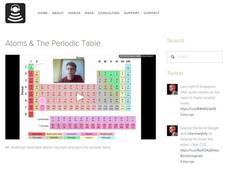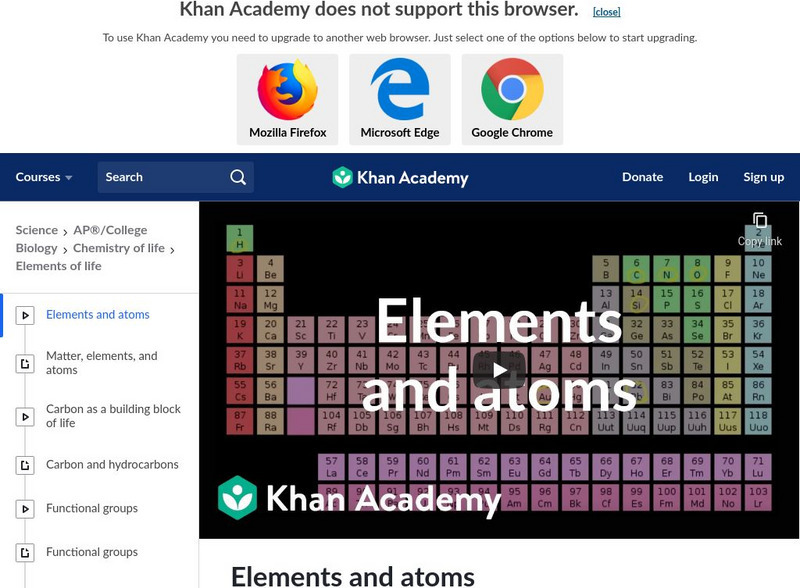SciShow
Strong Interaction: The Four Fundamental Forces of Physics #1b
There is a force stronger than electricity or gravity, so scientists named it the strong force. The video continues the explanation of the strong force and the way it works. It also describes the limitations, such as only working in very...
Fuse School
What is a Weighted Average?
Have you ever wondered why the atomic mass listed on the periodic table isn't a whole number? This video explains how weighted averages are calculated and relates the average to the relative atomic mass. Viewers are then given an element...
Bozeman Science
Atoms and the Periodic Table
After discovering plutonium, Glenn Seaborg was given the opportunity to determine its periodic symbol. Rather than going with the obvious Pl, he went with Pu as a joke. The designation was approved and is now on every periodic...
Bozeman Science
History of the Atom
Viewers learn about the history of our knowledge of atoms through the discoveries of eight different scientists: Mendeleev, Democritus, Dalton, Thompson, Schrodinger, Bohr, Rutherford, and Chadwick.
DoodleScience
Atomic Structure
The Rutheford plum pudding model of an atom, as well as the nuclear model, are the subject of a video that also includes an explanation of protons, neutrons, electrons, nucleus, atomic mass, atomic charge, and ions.
Crash Course
The Nucleus
Einstein didn't just discover relativity, he proved the existence of atoms in 1905 — more than 110 years ago. Discover how he did it and begin learning about basic chemistry: parts of an atom, atomic mass, atomic number, and how to read...
Educreations
Electron Configuration Example
What does an atom look like? The instructor in a tutorial video models how to use the periodic table to determine the number of subatomic particles. He then uses the number of electrons to create an orbital diagram. Finally, Groves...
Ricochet Science
Understanding Atomic Number and Atomic Mass
The amount of information you can learn about an element from the periodic table is amazing! Young scientists learn how to interpret the atomic number and atomic mass. Using a carbon atom as an example, the instructor describes the...
Ricochet Science
Isotopes
Altering the subatomic nature of an atom affects its properties. The video illustrates the idea of an isotope using Carbon-12, Carbon-13, and Carbon-14 as examples.
Ricochet Science
Structure of an Atom
Just because we can't see an atom doesn't mean we can't study it! The video examines the makeup of the atom. It explains the roles of the protons, neutrons, and electrons.
Berkeley University of California
Atomic Structure
How are atoms structured? Viewers of the video first learn about atoms and atomic structure, including the nucleus and electron shells. The video then describes how atomic numbers and atomic masses are expressed on atomic symbols. You'll...
Fuse School
Question - Matter Exam Question 1
How much does your class know about subatomic particles? Module 13 in a 14-part series tests their knowledge of how to determine an atom's number of protons, neutrons, and electrons when given the atomic number and the mass...
Fuse School
Question - Matter Exam Question 2
Looking for a great way to see what young chemists know about atomic structure? In the 14th and final installment in the states of matter series, learners put their skills to the test. The four-part question covers placement of...
PBS
Pbs Learning Media: Melissa Franklin: High Energy Physics
This video segment adapted from Discovering Women profiles Fermilab physicist and Harvard professor Melissa Franklin. [4:08]
Khan Academy
Khan Academy: Elements and Atoms
A video lecture that discusses how elements relate to atoms. Also discussed are protons, electrons, and neutrons. [13:08]
Khan Academy
Khan Academy: Elements and Atoms
Video tutorial explores how elements relate to atoms and provides the basics of how protons, electrons, and neutrons make up an atom. [13:08]
Khan Academy
Khan Academy: Atomic Number, Mass Number, and Isotopes
Check your understanding of how to use the atomic number and the mass number to represent different isotopes. [9:43]
Scholastic
Scholastic: Study Jams! Science: Energy, Light and Sound: Electricity
A video and a short quiz on electricity, covering static electricity, lightning, and energy generated from electricity. [3:20]
Khan Academy
Khan Academy: Biology Foundations: Elements and Atoms
How elements relate to atoms. The basics of how protons, electrons, and neutrons make up an atom. [13:09]
Khan Academy
Khan Academy: Introduction to the Atom
In this video, learn how atoms are made up of protons, neutrons, and electrons. Elements are defined by the atomic number, the number of protons in the nucleus. The mass of an atom is determined by the total number of protons and...
Sophia Learning
Sophia: Atomic Number: Lesson 2
This lesson explains what is represented by the atomic number, and how it varies from one element to the next. It is 2 of 7 in the series titled "Atomic Number."




















